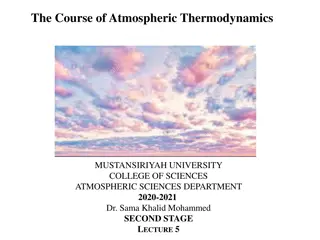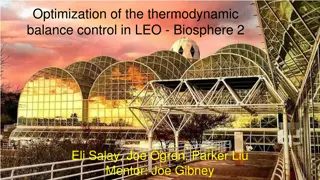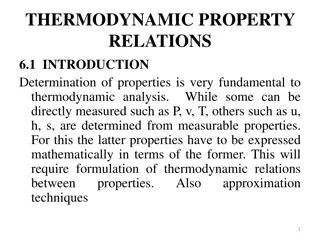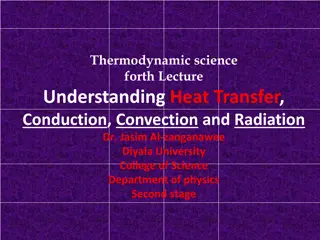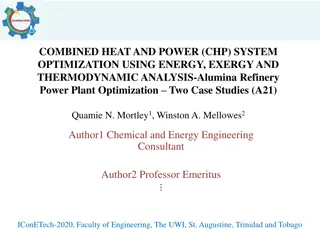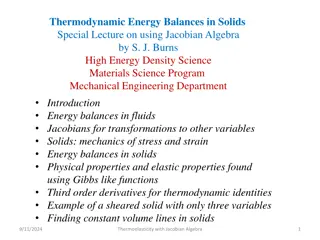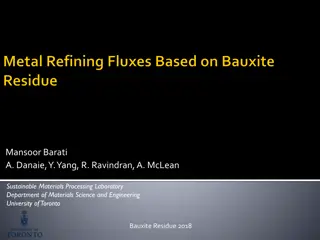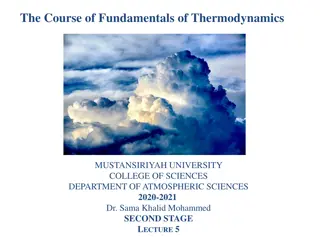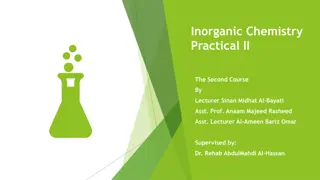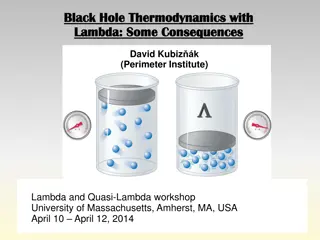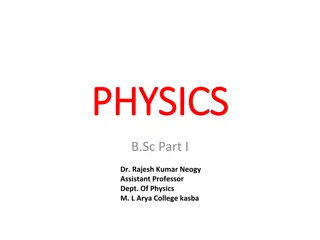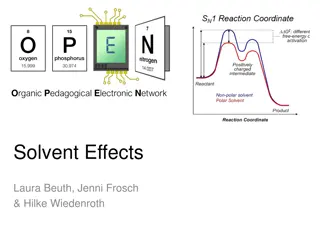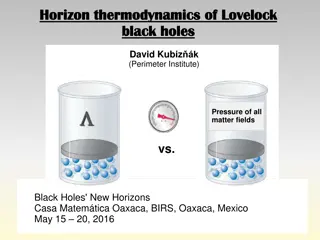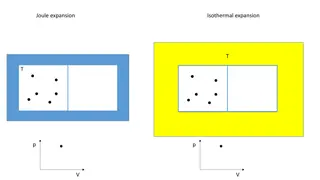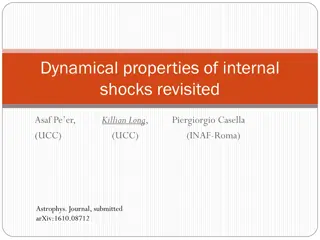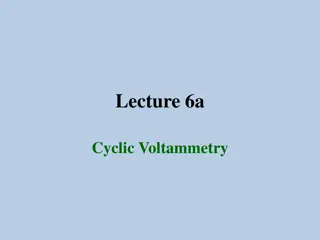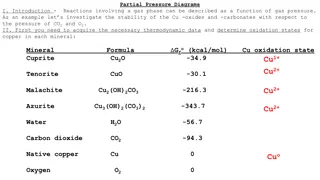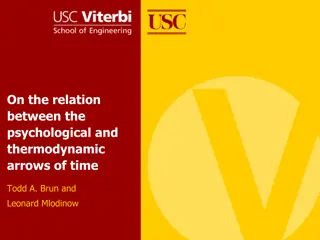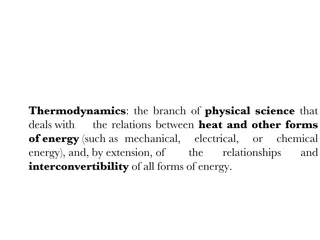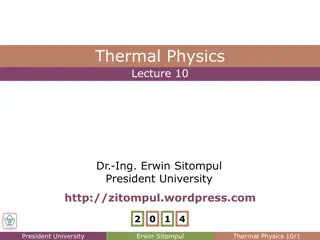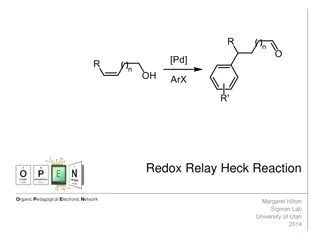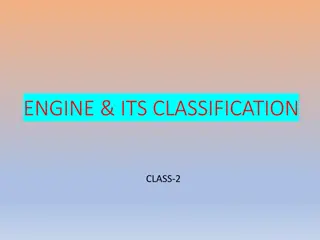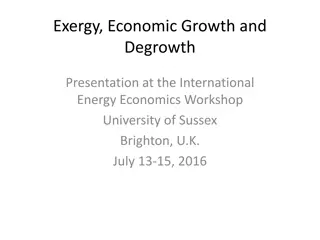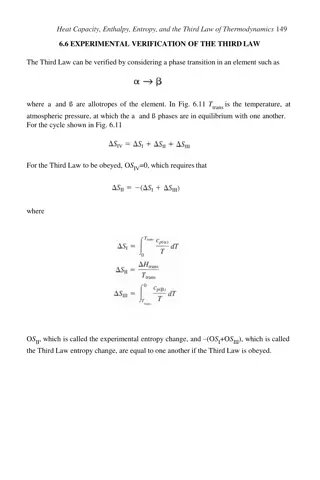Ginzburg Landau phenomenological Theory
The Ginzburg-Landau phenomenological theory explains superconductivity and superfluidity as distinct thermodynamic phases. It focuses on phase transitions characterized by singularities in specific heat at the transition temperature. Derived from BCS theory, it quantifies condensation energy, emphas
1 views • 38 slides
Understanding Thermodynamic and Kinetic Characteristics in Adsorption Systems
Explore the thermodynamics and kinetics of adsorption through discussions on equilibrium thermodynamics, adsorption isotherms, kinetic measurements, technical applications, and interaction forces. Learn about the distinctions between physisorption and chemisorption, as well as the terminology associ
0 views • 7 slides
Ask On Data for Efficient Data Wrangling in Data Engineering
In today's data-driven world, organizations rely on robust data engineering pipelines to collect, process, and analyze vast amounts of data efficiently. At the heart of these pipelines lies data wrangling, a critical process that involves cleaning, transforming, and preparing raw data for analysis.
2 views • 2 slides
Understanding Atmospheric Thermodynamics in Second Stage Lecture
Explore key concepts in atmospheric thermodynamics, including condensation level, free convection level, and the use of thermodynamic diagrams. Learn about the process of condensation, stability levels in the atmosphere, and the significance of free convection in weather patterns. Discover why therm
0 views • 27 slides
Optimization of Thermodynamic Balance Control in LEO Biosphere 2
The Landscape Evolution Observatory (LEO) within Biosphere 2 is a groundbreaking research site using advanced sensors to monitor and study water, carbon, and energy cycling in artificial landscapes. A team is working on optimizing thermodynamic control systems to maintain stable temperatures in LEO'
0 views • 12 slides
Fundamentals of Thermodynamic Property Relations
Determining thermodynamic properties is crucial for analysis, involving direct and derived properties expressed through formulations and relations. Partial derivatives, fundamental relations like the 1st and 2nd laws, and functions such as enthalpy, Helmholtz, and Gibbs are explored. Maxwell relatio
1 views • 56 slides
Thermodynamic Principles of Polymers in Solution: Flory-Huggins Theory and Macromolecular Solutions
Understanding the thermodynamic behavior of polymers in solution is crucial in various industrial and scientific applications. The Flory-Huggins theory provides insights into athermal macromolecular solutions, heat of mixtures, interaction parameters, and the concept of good vs. mediocre solvents. T
1 views • 77 slides
Understanding Heat Transfer in Thermodynamics Lecture
This thermodynamics lecture covers essential topics such as heat transfer, conduction, convection, and radiation. Dr. Jasim Al-zanganawee from Diyala University explains Thermodynamic Processes, Internal Energy, Properties of a System, and Thermodynamic Cycles. Students will learn about extensive an
0 views • 11 slides
Optimizing Combined Heat and Power Systems in Alumina Refineries
Thermodynamics plays a crucial role in optimizing Combined Heat and Power (CHP) systems in process industries like Alumina Refineries. This study focuses on minimizing losses and maximizing efficiency through energy, exergy, and thermodynamic analysis. By reconfiguring the system and utilizing low-g
0 views • 9 slides
Understanding Working Fluids in Thermodynamic Systems
Working fluids are essential in thermodynamic systems to transfer energy and perform work. This article explores the selection criteria, types, and work calculation involving working fluids in cogeneration and trigeneration systems. The properties, fluid types, and work processes are discussed to un
1 views • 14 slides
Carnot Cycle and Multi-Source Engine Characteristics
Carnot cycle is a thermodynamic process converting thermal energy into work, while a multi-source engine offers high efficiency, better reliability, and easier maintenance. It can run on various heat sources and is safe, modular, and flexible. The engine's mechanisms are simpler and suitable for low
11 views • 19 slides
Overview of IC Engine Testing and Types
Engine testing plays a crucial role in evaluating performance beyond calculations and design data, ensuring customer satisfaction. Commercial tests help determine power output, fuel consumption, and overall engine stability under various loads. Thermodynamic tests compare theoretical and actual perf
3 views • 40 slides
Understanding Thermodynamic Energy Balances in Solids with Jacobian Algebra
Explore the intricacies of energy balances in solids through the lens of Jacobian algebra, covering topics such as mechanics of stress and strain, Gibbs-like functions for physical properties, and third-order derivatives for thermodynamic identities. Unravel the application of Jacobians for transfor
2 views • 26 slides
Sustainable Processing of Bauxite Residue for Environmental Benefits
Sustainable Materials Processing Laboratory at the University of Toronto is focusing on innovative ways to neutralize acidic soil, treat mining wastes, and recover metals using bauxite residue. The research also delves into the properties of hot metal and steel, emphasizing steelmaking processes for
0 views • 22 slides
Fundamentals of Thermodynamics: Historical Laws and Principles
This lecture explores the historical overview of thermodynamic laws, including Boyle's Law, Charles' Law, and Gay-Lussac's Law. It delves into the relationships between pressure, temperature, volume, and amount in ideal gases, providing useful insights for meteorologists and atmospheric scientists.
0 views • 23 slides
Understanding Free Energy, Reaction Quotient, and Equilibrium Constant
This educational material delves into the concepts of free energy, reaction quotients, and equilibrium constants in chemical systems. It explains how to determine the direction of a reaction based on Q and K values, elucidates the role of Gibbs free energy in determining spontaneity, and provides ca
0 views • 10 slides
Exploring the Chemistry of Phosphorus: White, Red, and Black Phosphorus Forms
Dive into the world of phosphorus chemistry with a focus on its different forms - white, red, and black phosphorus. Learn about the unique properties, structures, and reactions of each form, from the instability of white phosphorus to the thermodynamic stability of black phosphorus. Discover how the
0 views • 16 slides
Exploring Black Hole Thermodynamics and Lambda Effects: Insights and Consequences
Delve into the complex interplay between black hole thermodynamics and the cosmological constant Lambda, uncovering intriguing implications and theoretical challenges. Dive deep into the thermodynamic properties of black holes, the role of pressure and volume, and the intriguing parallels to everyda
0 views • 29 slides
Understanding Air Masses in Meteorology
Air masses play a significant role in meteorology, covering vast areas with uniform physical properties. They are classified based on temperature, moisture content, and source regions, which can be continental or maritime. Air masses form in regions with little wind and can sit over an area for an e
0 views • 27 slides
Understanding Heat Transfer and Thermal Insulation
Explore the concepts of heat transfer, thermal insulation, thermodynamic systems, temperature, and means of heat transfer. Learn about conduction, convection, and radiation and how they impact the equilibrium and transfer of thermal energy. Gain insights into designing containers to minimize heat lo
0 views • 30 slides
Introduction to Thermodynamics: Laws, Concepts, and Applications
Thermodynamics is the study of energy and its transformations within systems. This article delves into the laws of thermodynamics, defining key quantities like temperature and entropy. It explains the importance of thermodynamic systems, boundaries, and surroundings, highlighting closed, open, and i
0 views • 12 slides
Understanding Solvent Effects in Organic Chemistry
Different solvents can have varying effects on chemical reactions by influencing solubility, stability, and reaction rates. Solvents can control the pathway towards forming either thermodynamic or kinetic products based on their selection. Solutes dissolve based on intermolecular interactions with s
0 views • 6 slides
Horizon Thermodynamics of Lovelock Black Holes by David Kubiz
Gravitational dynamics and thermodynamics in Lovelock black holes are explored in this talk, discussing free energy, universal thermodynamic behavior, Lovelock gravity, and beyond spherical symmetry. References include works on black hole thermodynamics, local Rindler horizons, and apparent horizons
0 views • 25 slides
Visual Guide to Joule Expansion in Isothermal Process
Explore the Joule expansion process in an isothermal setting through a series of informative images. Witness the changes in temperature, pressure, and volume as the system undergoes expansion. Gain a deeper understanding of this fundamental thermodynamic concept through visually engaging representat
0 views • 9 slides
Revisiting Dynamical Properties of Internal Shocks in Astrophysics
This study investigates the dynamical properties of internal shocks in astrophysical phenomena such as gamma-ray bursts. It delves into the rapid variability in X-ray light curves and explores the mechanisms behind colliding plasma shells, providing insights into shock wave interactions and thermody
0 views • 13 slides
Understanding Cyclic Voltammetry in Electrochemical Methods
Electrochemical methods, such as cyclic voltammetry, are crucial for studying electron transfer processes, redox reactions, and adsorption on surfaces. Cyclic voltammetry involves varying the applied potential at a working electrode to monitor electron flow and chemical reactions. Peaks in the curre
0 views • 11 slides
Thermodynamics Tutorial: Exergy Analysis of Processes
In this tutorial, we delve into the analysis of thermodynamic processes through the concept of exergy. We explore the determination of exergy destroyed, reversible work, equilibrium temperatures, wasted work potential, and more in various scenarios involving insulated systems. Detailed calculations
0 views • 15 slides
Analysis of Cu Minerals Stability in Various Gas Pressures
Investigating the stability of various copper minerals (Cuprite, Tenorite, Malachite, Azurite) in relation to the partial pressures of CO2 and O2 gases. Thermodynamic data and equilibrium constants are used to determine equilibrium O2 pressures for reactions involving copper minerals and oxygen. The
0 views • 10 slides
Exploring the Relationship Between the Psychological and Thermodynamic Arrows of Time
Time, as a fundamental concept, exhibits a unidirectional flow from past to future, captured in both psychological and thermodynamic contexts. This article delves into the intriguing interplay between Newtonian dynamics and our intuitive perception of time's arrow, highlighting the challenges in rec
0 views • 28 slides
Understanding Thermodynamics: The Science of Energy Relations
Thermodynamics is a branch of physical science that focuses on the relationships between heat and various forms of energy, exploring the interconvertibility of energy types. It involves the study of systems, surroundings, phases, components, and reactions, with a primary focus on macroscopic energie
0 views • 99 slides
Understanding Refrigerators and Second Law of Thermodynamics
Refrigerators are devices that transfer energy between low and high-temperature reservoirs using work. This process involves various thermodynamic cycles like the heat pump cycle and air conditioner cycle. The efficiency of refrigerators is described by the coefficient of performance, which is cruci
0 views • 8 slides
Understanding Electrolyte Activity Coefficients and Equilibrium Constants
This article delves into the practical aspects of dealing with individual ions in aqueous solutions, particularly focusing on partitioning thermodynamic parameters between ions in salts. It explores the Debye-Hückel theory, which explains the electrostatic interactions between ions in solution and
0 views • 20 slides
Understanding the Redox-Relay Heck Reaction in Organic Synthesis
The Redox-Relay Heck Reaction is a powerful tool in organic synthesis that allows for the functionalization of olefins with aryl groups. Developed by Sigman and colleagues, this reaction involves a palladium-catalyzed relay controlled by a thermodynamic sink, leading to the formation of aldehydes or
0 views • 6 slides
Understanding Atmospheric Composition and Structure
The presentation covers fundamental concepts related to the Earth's atmosphere, including its composition, origin of oxygen, dry and moist layers, standard atmosphere layers, and temperature variations. Key topics discussed include the primordial atmosphere, atmospheric constituents, water vapor dis
0 views • 58 slides
Understanding Air Conditioning and Psychrometrics in HVAC Systems
Air conditioning systems in HVAC aim to control temperature, humidity, air movement, and air quality for comfort and process control. Psychrometrics studies air-water vapor mixtures, with key parameters like dry bulb temperature and relative humidity. Important psychrometric processes involve adiaba
0 views • 65 slides
Satellite Applications in Estimating Earth's Surface Energy Budget
Satellites play a crucial role in estimating the Surface Energy Budget (SEB) by providing data on various components such as Surface Radiation Budget and Surface Turbulent Fluxes. The SEB includes factors like net radiation flux, sensible and latent heat fluxes, and subsurface heat transfer. Satelli
0 views • 38 slides
Understanding Engine Classification and Design
Engine classification involves categorizing engines based on various factors such as combustion type, number of strokes, cylinder design, and ignition method. Common classifications include external and internal combustion engines, as well as categories based on the design and use of the engine. Add
0 views • 11 slides
Thermodynamic Calculators for Comprehensive Analysis of Systems, Processes, and Cycles
Explore a series of simplification in the TESTcalc Tree, leading to the accurate analysis tool system states and basic tools for uniform and non-uniform systems. Access TESTapps for a variety of thermodynamic calculators catering to specific, generic, mixing, non-mixing, and combustion systems, alon
0 views • 12 slides
Exergy, Economic Growth, and Degrowth: A Critical Perspective
This presentation delves into the relationship between exergy, economic growth, and degrowth from a thermodynamic perspective, exploring the origins of exergy-economics and physical ideas. It emphasizes the importance of exergy as a measure of useful work in economic systems, contrasting energy and
0 views • 39 slides
Thermodynamics of Materials: Experimental Verification and Entropy Analysis
Verification of the Third Law of Thermodynamics through the study of phase transitions in elements like sulfur, exemplifying the relationship between heat capacity, enthalpy, entropy, and the Third Law. Experimental data on entropy changes and molar entropies, as well as insights into the behavior o
0 views • 24 slides



